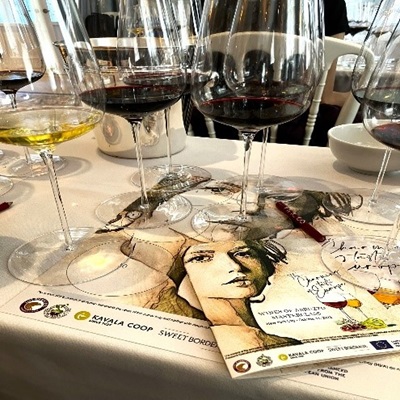Renowned for its commitment to environmental sustainability, Abruzzo has earned a well-deserved reputation as one of the greenest regions in Europe. This picturesque locale is primarily characterized by its undulating and mountainous terrain, which covers an impressive 99% of its land. Notable among these natural wonders is the majestic Gran Sasso massif, which stands as the highest peak in the Apennines Mountain range.
Abruzzo’s climate is equally alluring. The Adriatic coastline, stretching over 130 kilometers, offers a climate that beautifully merges the refreshing sea breezes of the Mediterranean with the temperate influences from the interior mountain ranges.
Abruzzo Wine Roots
As early as the 6th century BC, inhabitants of Abruzzo were likely savoring Abruzzo wine crafted by the Etruscans. Today, this rich tradition endures with approximately 250 wineries, 35 cooperatives, and over 6,000 grape growers, with vineyards covering 34,000 hectares yielding an impressive 1.2 million bottles of wine annually. Remarkably, 65% of this production is destined for international markets, generating an annual revenue of approximately $319 million.
The star of red grape varieties is Montepulciano d’Abruzzo, accounting for roughly 80% of the region’s production, although Merlot, Cabernet Sauvignon, and other red varietals are also available. Notably, the unique white grape Pecorino, named after the sheep that once grazed in the vineyards, captivates with a floral bouquet, notes of lemon, white peach, spices, crisp acidity, and a hint of salty minerality. Additionally, other regional white grapes, like Trebbiano and Cococciola, contribute to Abruzzo’s diverse viticultural landscape.
Cerasuolo d’Abruzzo, a distinctive pink wine hailing from the Abruzzo region, is a rarity, with its vineyards occupying a mere 970 hectares, a stark contrast to the expanses dedicated to Montepulciano and Trebbiano d’Abruzzo DO wines. To qualify as Cerasuolo d’Abruzzo, the wine must comprise a minimum of 85% Montepulciano grapes, while the remaining 15% can incorporate locally sanctioned grape varieties. In practice, many Cerasuolo d’Abruzzo wines are crafted exclusively from 100% Montepulciano grapes. These wines are permitted to hit the market on January 1st of the year following the harvest.
For the elevated tier of Cerasuolo d’Abruzzo Superiore, more rigorous standards come into play. It must boast a higher minimum alcohol by volume (ABV) of 12.5%, as opposed to the standard 12%, and undergo a more extended minimum maturation period, typically around four months instead of the standard two.
Cerasuolo d’Abruzzo, often referred to as the “rose of Abruzzo,” derives its rich hue from a brief 24-hour maceration, during which color and tannins are extracted due to the substantial anthocyanin content in the grape’s skin. This differs from lighter rosés that separate the juice from the skins immediately.
Prior to bottling, Cerasuolo d’Abruzzo is frequently aged in stainless steel, resulting in a fruity profile imbued with a touch of delicate acidity, a character influenced by the region’s abundant sunlight, elevated altitudes, and refreshing mountain breezes. The finest examples of this wine exhibit well-integrated tannins and a wealth of intense red fruit flavors that only improve with age. If you’re seeking an alternative to the typical Provence-style rosé and relish lighter reds akin to Beaujolais Villages, Cerasuolo d’Abruzzo stands as an enchanting choice.
Quality Gets Attention
Over the past two decades, Abruzzo has experienced a remarkable transformation in its winemaking industry, with a dedicated focus on enhancing wine quality. Families deeply rooted in this rich winemaking tradition have taken immense pride in their craft, showcasing their commitment by prominently displaying their names on wine labels. This renewed emphasis on terroir, including factors such as soil composition, slope orientation, climate, and winemaking philosophy, has substantially elevated the region’s winemaking standards. Innovative techniques have also included extended oak aging, battonage applied to Pecorino wines, and experimenting with fermenting wine in terracotta tanks as an alternative to traditional stainless steel. These innovations collectively contribute to elevating Abruzzo’s reputation on the global wine stage.
Certification holds an important place in distinguishing Abruzzo wines from others. Given the region’s wine-grape-loving climate, a considerable number of vineyards in Abruzzo have adopted organic farming practices. Many wineries in the region proudly display organic seals or the word BIO on their labels, signifying their commitment to organic viticulture. Several wineries practice organic farming but have yet to obtain official certification. This emphasis on organic methods often results in wines with purer fruit flavors and unique textures, contributing to the distinctive character of Abruzzo wines.
Wineries are also exploring unique certifications to set themselves apart.
Some have pursued certifications such as Vegan Certified and Equality Diversity and Inclusion, a new certification offered by Arborus. These certifications reflect the region’s commitment to sustainability, inclusivity, and catering to diverse consumer preferences.
Soil
The vineyard soils of Abruzzo are noted for the presence of sand and clay. This unique soil composition contributes to the distinct qualities and characteristics of the wines produced in the region. Sandy soils have excellent drainage properties, allowing excess water to pass through quickly. This characteristic I particularly beneficial in regions with high rainfall as it prevents waterlogging and helps to maintain a balanced moisture level for the grapevines. Additionally, the warmth-absorbing properties of sand can create a favorable microclimate for wine growth. The warmth retained during the day is gradually released during the cooler nights, which can promote even ripening of the grapes. The results? Wines with vibrant fruit flavors, good acidity, and a certain finesse.
Clay soils have a high water-holding capacity, advantageous in drier years as they ensure that the grapevines have access to a steady supply of moisture. This helps the vines endure periods of drought and contributes to the development of grapes with more concentration and depth of flavor. Clay also retains minerals and nutrients that are gradually released to the grapevines, enhancing the overall health and complexity of the wines.
The combination of sand and clay makes the Abruzzo vineyard soils balanced between drainage and moisture retention and is essential for grapevine growth, preventing the roots from becoming waterlogged while ensuring a steady water supply during dry periods. The presence of minerals in the clay can lend a distinctive mineral character to the wines, adding to their complexity and depth.
Vine Training
The traditional vine training system in Abruzzo, known as the “pergola abruzzese,” is deeply rooted in the region’s winemaking heritage and has played a pivotal role in the cultivation of the vines. The method is characterized by its use of vertical wooden poles and a network of scaffolding or iron wires, meticulously designed to support the vine branches displaying profound wisdom and purpose.
Production
Abruzzo’s wine production is divided into 42% white, 58% red and rose (rosato) wines. Notably, the region is known for the famous Cerasuolo d’Abruzzo, considered one of Italy’s best rose wines. While Trebbiano Toscano and Trebbiano Abruzzese remain the primary white varietals, indigenous varieties like Pecorino, Passerina, Cocociola, and Montonico are gaining prominence, adding diversity to the wine offerings.
DOC, DOCG
In Italy, wines are classified and regulated based on their quality, origin, and grape varieties. The two important classifications for Italian wines are DOC (Denominazione di Origine, Controllata) and DOCG (Denominazine di Origine Controllata e Garantita).
A DOC designation specifies the geographic area where the grapes are grown and the wine produced. In Abruzzo the DOC regions include Montepulciano d’Abruzzo, Trebbiano d’Abruzzo and Cerasuolo d’Abruzzo. The DOC regulations outline which grape varieties can be used in the production of wines in that region. In Montepulciano d’Abruzzo DOC there must be at least 85% Montepulciano grapes used for the making of red wines. DOC wines must adhere to specific production methods including rules on aging, alcohol content, etc. with the intention of maintaining quality and traditional wine characteristics. The DOC wines are monitored and certified by a regulatory body to ensure they meet the established standards, assuring consumers of the wine’s authenticity and quality.
A DOCG designation is a higher-tier classification indicating even stricter regulations and guaranteed quality. DOCG wines undergo rigorous testing and scrutiny to ensure exceptional quality and represent the best of their respective regions. The regions frequently are geographically specific. In Abruzzo, Montepulciano d’Abruzzo Colline Termane is a subzone within Montepulciano d’Abruzzo DOCG, known for producing top-quality wines. There are often limits on the maximum yield per hectare to ensure the grapes used in these wines are of the highest quality. There is also a seal of Guarantee on the bottleneck to guarantee authenticity and quality.
Future
Abruzzo wines have a bright domestic and international future thanks to their commitment to quality, sustainability, and the promotion of their unique indigenous grape varieties. The region’s rich wine heritage, combined with its dedication to improvement and innovation, makes it a promising player in the global wine industry.
In My Opinion
1. Fattoria Nicodemi. 2021 Trebbiano d’Abruzzo DOC Cocciopesto. Abruzzo
A unique and meticulously crafted wine:
· Terroir: The vineyard thrives in medium-textured limestone and clay soils.
· Vine Training: Utilizing the Abruzzo Pergola training system with an impressive density of 1600 plants per hectare.
· Vineyard Age: The vines in this vineyard are 50 years old, contributing to the wine’s depth and character.
· Winemaking Process: The grapes undergo destemming, but no pressing.
· Fermentation: Natural or ambient yeasts are used.
· Maceration: The wine goes through a maceration process that lasts for 5 months, with manual punching down performed during the initial 15 days.
· Maturation: After racking, the wine returns to the cocciopesto tank for further refinement.
Cocciopesto Jars: These unique jars are crafted from a mixture of raw bricks, stone fragments, sand, binder, and water; air-dried for a minimum of 30 days.
· Micro-Oxygenation: The cocciopesto jars play a pivotal role in enhancing the wine’s organoleptic qualities and aromas. Their specific micro-positioning ensures a controlled micro-oxygenation that enriches the wine without imparting any unwanted scents.
· Wine Character: The result is a finely nuanced and delicate wine, distinguished by its pronounced mineral character.
· Bottling: The wine is bottled without filtration, maintaining its purity and depth.
· Aging: The wine is aged for an additional three months to reach its full potential.
Notes:
· Color: Exhibits a straw-yellow hue with lemon highlights
· Aromas: The bouquet is graced by delicate floral notes, providing an elegant and fragrant olfactory experience
· Palate: The wine presents a delightful blend of honey and vibrant fruit flavors, harmoniously accompanied by minerality. The result is an unexpected and dynamic tasting journey
· Progression: With each sip the wine unfolds in complexity, showcasing its remarkable finesse and a refined, well-balanced character.
· Overall: Characterized by a delightful floral and herbaceous nose, a lively and mineral-driven palate, and an evolving, elegant nature.
2. Barone Cornacchia. 2021 Trebbiano d’Abruzzo DOC Poggio Varano. 100% Trebbiano. Certified organic from calcareous stony soil.
Fermentation occurs spontaneously, thanks to the action of indigenous yeasts. The journey begins with crushing, destemming, and the fermentation of grapes with their skins intact. Maceration is meticulously extended for 32 days in stainless steel tanks, maintaining a controlled temperature between 16-18 degrees Celsius. Following this prolonged maceration, the juice is gently separated from the skins through a soft press. The wine then undergoes a maturation period of 12 months in stainless steel tanks on its lees. Regular batonnage keeps the lees in suspension, adding depth and complexity. The final touch is an aging period in the bottle for approximately 6 months, allowing the wine to evolve and reach its full potential.
Notes:
· In the glass, Barone Cornacchia’s 2021 Trebbiano d’Abruzzo DOC Poggio Varano presents an intense, deep yellow color with captivating golden and amber highlights.
· Aroma: The wine exudes a bouquet rich in ripe and dried fruit notes, complemented by delicate hints of rose petals. Subtle herbal nuances of mint and sage add depth and complexity to the aromatic profile.
· Palate: The wine boasts a full and round body that captivates the senses. The journey culminates in a lingering finish, offering intriguing suggestions of bitterness that enhance the overall tasting experience.
© Dr. Elinor Garely. This copyright article, including photos, may not be reproduced without written permission from the author.























